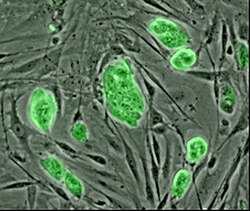Blog post #5
5/1000
Hi everyone for this 5th post I have chosen to write about stem cells. The stem cells are medical future!
I have gathered some texts from wikipedia about stem cells. I know that many of you will not understand much because you are not into the medicine so much. I will explain later the texts.
I will not try to explain much about the stem cells, but I will focus on what can they be used for in medicine.
But however here is a small info about cells them self:
" Stem cells are biological cells found in all multicellular organisms, that can divide (through mitosis) and differentiate into diverse specialized cell types and can self-renew to produce more stem cells. In mammals, there are two broad types of stem cells: embryonic stem cells, which are isolated from the inner cell mass of blastocysts, and adult stem cells, which are found in various tissues. In adult organisms, stem cells and progenitor cells act as a repair system for the body, replenishing adult tissues. In a developing embryo, stem cells can differentiate into all the specialized cells[ectoderm,endoderm and mesoderm-see induced pluripotent stem cells] (these are called pluripotent cells), but also maintain the normal turnover of regenerative organs, such as blood, skin, or intestinal tissues.
There are three accessible sources of autologous adult stem cells in humans:
Bone marrow, which requires extraction by harvesting, that is, drilling into bone (typically the femur or iliac crest),
Adipose tissue (lipid cells), which requires extraction by liposuction, and
Blood, which requires extraction through pheresis, wherein blood is drawn from the donor (similar to a blood donation), passed through a machine that extracts the stem cells and returns other portions of the blood to the donor.
Stem cells can also be taken from umbilical cord blood just after birth. Of all stem cell types, autologous harvesting involves the least risk. By definition, autologous cells are obtained from one's own body, just as one may bank his or her own blood for elective surgical procedures.
Highly plastic adult stem cells are routinely used in medical therapies, for example in bone marrow transplantation. Stem cells can now be artificially grown and transformed (differentiated) into specialized cell types with characteristics consistent with cells of various tissues such as muscles or nerves through cell culture. Embryonic cell lines and autologous embryonic stem cells generated through therapeutic cloning have also been proposed as promising candidates for future therapies. Research into stem cells grew out of findings by Ernest A. McCulloch and James E. Till at the University of Toronto in the 1960s. "

Stem Cells (green ones)
This was gathered from Wikipedia if you want to read more about stem cells follow wikipedia link below.
Stem cells on wikipedia (On science language)
Now what text above says is that these cells can divide and self-renew and can become sub for any other cell type one would need.
Now what I am trying to do is to spread the word about this way of curing many health problems.
Medical researchers believe that stem cell therapy has the potential to dramatically change the treatment of human disease. A number of adult stem cell therapies already exist, particularly bone marrow transplants that are used to treat leukemia. In the future, medical researchers anticipate being able to use technologies derived from stem cell research to treat a wider variety of diseases including cancer, Parkinson's disease, spinal cord injuries, Amyotrophic lateral sclerosis, multiple sclerosis, and muscle damage, amongst a number of other impairments and conditions However, there still exists a great deal of social and scientific uncertainty surrounding stem cell research, which could possibly be overcome through public debate and future research, and further education of the public.
One concern of treatment is the risk that transplanted stem cells could form tumors and become cancerous if cell division continues uncontrollably.
Stem cells are widely studied, for their potential therapeutic use and for their inherent interest.
Supporters of embryonic stem cell research argue that such research should be pursued because the resultant treatments could have significant medical potential. It has been proposed that surplus embryos created for in vitro fertilization could be donated with consent and used for the research.
The recent development of iPS cells has been called a bypass of the legal controversy. Laws limiting the destruction of human embryos have been credited for being the reason for development of iPS cells, but it is still not completely clear whether hiPS cells are equivalent to hES cells. Recent work demonstrates hotspots of aberrant epigenomic reprogramming in hiPS cells.

Stem cells already have usage in curing spinal cord injury and healing problems of people who cant walk anymore. There are stem cells treatments which help people to get up from wheel chairs!
But unfortunately such treatments are still very expensive! Lets us hope that the price of such treatments will reduce so that it is available to wider population!
I hope I learnt you something new today! This was kind of a science post but I wanted to spread the word about this thing because it is good for everyone to know about it!
Hi Tigrasa,
ReplyDeleteNice article you've written :) I had no idea stem cells could be used to help people walk again. Are you in favor of harvesting or more just putting out useful information for us to enjoy?
Big week back at Dear Blogger coming up. Sorry for any confusion there lately - I've been growing and like any growth spurt it feels a bit goofy! Would love to have you participate in the activities though!
Hopefully cya soon,
Greg